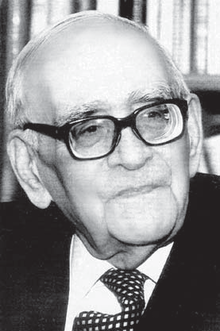
Summary
Mahmoud Hessabi (or Hessaby, Persian: محمود حسابی, February 23, 1903 – September 3, 1992) was an Iranian nuclear physicist and senator.[1] He was the minister of education in the cabinet of Prime Minister Mohammad Mosaddegh from 1951 to 1952.[2]
Mahmoud Hessabi | |
|---|---|
 Mahmoud Hessabi | |
| Minister of Culture and Higher Education | |
| In office 6 May 1951 – 16 July 1952 | |
| Prime Minister | Mohammad Mosaddegh |
| Preceded by | Karim Sanjabi |
| Succeeded by | Mehdi Azar |
| Senator from Tehran | |
| In office 22 January 1950 – 9 May 1961 | |
| Appointed by | Mohammad Reza Pahlavi |
| Personal details | |
| Born | 23 February 1903 Tehran, Iran |
| Died | 3 September 1992 (aged 89) Geneva, Switzerland |
| Resting place | Tafresh, Iran |
| Alma mater | American University of Beirut, Sorbonne, École Superieure d'Electricité |
| Occupation | scientist |
Life edit
Hessabi was born in Tehran to the family of Abbas and Goharshad Hessabi. His family's hometown is Tafresh, Markazi province, Iran.[3] His family moved to Beirut in 1907 when his father was appointed consul at the Iranian embassy.[4] There Hessabi attended primary school. He was still in secondary school when World War I started prompting the closure of his school; Hessabi continued his education at home and in 1922, he earned a degree in road engineering from the American University of Beirut. After briefly working for the Ministry of Roads, Beirut, Hessabi travelled to Paris for further education, he was awarded a degree in electrical engineering at the École Superieure d'Electricité and later a doctorate degree in 1927. In Paris, he worked with Aime Cotton.[5]
In Tehran, Hessabi was affiliated with the University of Tehran and organized the science and engineering faculties of the university; He was teacher of Alenush Terian while she studied at the university.[6] In June 1951, Hessabi was appointed to a three-man provincial board of the Iranian oil company, the designated successor of the Anglo-Iranian Oil Company. In December, 1951, he replaced Karim Sanjaby as minister of education.[1] Between 1961 and 1969, Hessabi was Iran's representative on the Scientific and Technical Subcommittee of the United Nations Committee on the Peaceful Uses of Outer Space.
Museum edit
In 1992 his house changed to a museum to for recognition of his life. The Mahmoud Hessabi museum is located Tajrish neighborhood in Tehran.
Selected works edit
- Hessaby M. (1947). "Continuous Particles". Proceedings of the National Academy of Sciences of the United States of America. 33 (6): 189–194. Bibcode:1947PNAS...33..189H. doi:10.1073/pnas.33.6.189. PMC 1079021. PMID 16588741.
- Hessaby M. (May 1948). "Theoretical Evidence for the Existence of a Light-Charged Particle of Mass Greater than That of the Electron". Phys. Rev. 73 (9=): 1128. Bibcode:1948PhRv...73.1128H. doi:10.1103/PhysRev.73.1128.
See also edit
References edit
- ^ a b "Iran Bank Fights Drain on Exchange: Opening of Credit Abroad for Imports Suspended in Step to Protect Currency". The New York Times. New York. 5 December 1951.
- ^ Alexander, Yonah; Nanes, Allan S. (1980). The United States and Iran: A Documentary History. Aletheia Books. p. 244. ISBN 9780890933787.
- ^ "Iranian Personalities: Professor Mahmoud Hessabi". Iran Chamber Society.
- ^ H. E. Chehabi; Hassan I. Mneimneh (2007). "Five Centuries of Lebanese–Iranian Encounters". In H. E. Chehabi (ed.). Distant Relations: Iran and Lebanon in the Last 500 Years. New York: I.B. Tauris. p. 18. ISBN 9781860645617.
- ^ Tarikhi, Parviz (2014). The Iranian Space Endeavor: Ambitions and Reality. Springer. p. 47.
- ^ Talebian, Mohammad; Talebian, Ehsan (2012). "Alenush Terian: The Iranian Solar Mother". Physics in Perspective. 14 (2): 239–241. Bibcode:2012PhP....14..239T. doi:10.1007/s00016-012-0085-x. S2CID 120601020.
External links edit
- Hessaby Foundation
- Media related to Mahmoud Hessabi at Wikimedia Commons


